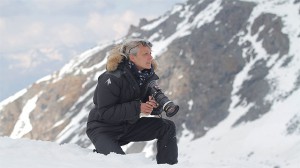A wiry, athletic Frenchwoman in her early 60s, the soft-spoken Godard began her career as a camera assistant working with the likes of Wim Wenders on Paris, Texas and Wings of Desire. Since 1991, she has been the cinematographer most closely associated with Claire Denis, the fearless French director of Beau Travail, Trouble Every Day, and numerous other sensuous, startling and enigmatic films.
Godard was in the Bay Area last weekend to introduce several films from Dancing With Light: The Cinematography of Agnès Godard, a Pacific Film Archive retrospective that inevitably includes several Denis titles. (The series wraps with screenings on June 26 and 28, although Godard’s visit has concluded and she won’t be on hand.)
Denis and Godard’s films together are distinguished by, among other things, sequences of uncomfortable sexual tension. Sometimes the relationships are inappropriate, which triggers our moral protectiveness and defensiveness. But the tension is enhanced by Godard’s intimate, probing handheld camerawork, which insinuates us so deeply into the scene that it’s impossible for us to remain distant, passive observers.
“I never thought about that,” Godard says, to my surprise. “Claire always chooses actors that are beautiful. This beauty is already part of the sexual [dynamic]. Then, in almost all her films there’s a dance sequence. I like to dance myself, that’s for sure. I like to shoot dance sequences because it’s done handheld. It’s like you are dancing, also. That means there is also music when we shoot, so this is just fantastic because you forget everything, the weight of the camera, technical difficulties and everything.”

Nenette and Boni
As our time winds down, I ask Godard which dead or retired director — which artist whose career predates her — she would most like to have worked with. I thought this would be a fun exercise, but Godard silently submerges herself in a century of cinema history.
Her initial reply is Alfred Hitchcock, an unexpected choice because Hitch storyboarded his films before going into production and isn’t thought of as a director who collaborated with his cinematographers. Godard surprises me again by citing Yasujiro Ozu and Kenji Mizoguchi, the brilliant Japanese directors whose meticulously and precisely composed films are vastly different visually from Godard and Denis’ work. (The common thread is Godard’s absolute love for character-driven stories.)
Only then does Godard turn to France’s legion of great directors, naming Jean Renoir and Partie de Compagne (A Day in the Country) and Robert Bresson (Pickpocket). Unpredictable to the last, Godard then calls forth John Huston, singling out his least-known and most underrated film, Fat City, adapted from Leonard Gardner’s Stockton-set novel about people on the fringes of the boxing world and society.
“And the very first, first film,” she adds with a smile, “the train arriving in the station.” To be there at the beginning with the Lumiere brothers, figuring out how to make images, would have been incredible for Godard. No matter, though, every new project brings the challenge and undiluted joy of creating images.
Dancing With Light: The Cinematography of Agnès Godard concludes Wednesday, June 26 at 7pm with Nenette and Boni and Friday, June 28 at 7pm with 35 Shots of Rum at the Pacific Film Archive in Berkeley. For more information visit bampfa.berkeley.edu.




